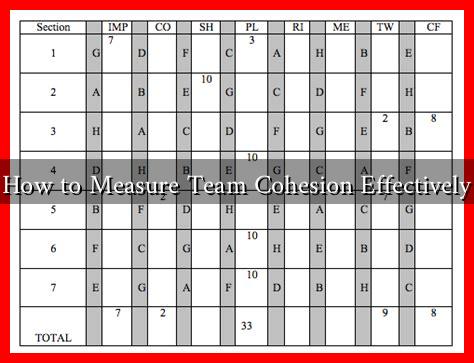-
Table of Contents
How to Measure Team Cohesion Effectively
Team cohesion is a critical factor in the success of any organization. It refers to the bonds that hold a team together, influencing collaboration, communication, and overall performance. Measuring team cohesion effectively can help leaders identify strengths and weaknesses within their teams, ultimately leading to improved productivity and morale. In this article, we will explore various methods and tools to measure team cohesion, supported by examples and case studies.
Understanding Team Cohesion
Before diving into measurement techniques, it’s essential to understand what team cohesion entails. Cohesion can be defined as the degree to which team members are attracted to the team and motivated to remain part of it. It encompasses several dimensions, including:
- Interpersonal Relationships: The quality of relationships among team members.
- Shared Goals: The extent to which team members are aligned in their objectives.
- Trust and Support: The level of trust and support members provide each other.
- Communication: The effectiveness of communication within the team.
Methods to Measure Team Cohesion
There are several effective methods to measure team cohesion, each with its own advantages and limitations. Here are some of the most widely used approaches:
1. Surveys and Questionnaires
Surveys are one of the most common methods for assessing team cohesion. They can be designed to evaluate various aspects of cohesion, such as trust, communication, and shared goals. Tools like the Team Cohesion Questionnaire (TCQ) or the Group Environment Questionnaire (GEQ) can provide valuable insights.
- Example: A study conducted by Carron et al. (2002) utilized the GEQ to measure cohesion in sports teams, revealing a strong correlation between cohesion and performance.
2. Observational Methods
Observational methods involve watching team interactions in real-time. This qualitative approach allows leaders to assess dynamics that may not be captured in surveys. Observers can note behaviors such as collaboration, conflict resolution, and communication styles.
- Case Study: A tech company implemented observational assessments during team meetings, leading to the identification of communication barriers that were subsequently addressed, resulting in a 20% increase in project completion rates.
3. Team Performance Metrics
Analyzing team performance metrics can also provide insights into cohesion. Metrics such as project completion rates, quality of work, and employee turnover can indicate how well a team is functioning together.
- Statistic: According to a Gallup study, teams with high cohesion experience 21% greater profitability and 17% higher productivity.
4. 360-Degree Feedback
360-degree feedback involves gathering input from all team members, including peers, supervisors, and subordinates. This comprehensive approach can highlight areas of strength and opportunities for improvement in team cohesion.
- Example: A multinational corporation used 360-degree feedback to assess team dynamics, leading to targeted training sessions that improved cohesion and reduced conflict.
Implementing Changes Based on Measurement
Once team cohesion has been measured, it’s crucial to act on the findings. Here are some strategies to enhance cohesion:
- Team-Building Activities: Organize regular team-building exercises to strengthen relationships.
- Open Communication Channels: Foster an environment where team members feel comfortable sharing ideas and concerns.
- Set Clear Goals: Ensure that all team members understand and are aligned with the team’s objectives.
- Provide Support: Encourage a culture of support where team members help each other succeed.
Conclusion
Measuring team cohesion is essential for any organization aiming to enhance performance and employee satisfaction. By utilizing surveys, observational methods, performance metrics, and 360-degree feedback, leaders can gain valuable insights into their teams’ dynamics. Implementing changes based on these measurements can lead to improved collaboration, communication, and overall success. Remember, a cohesive team is not just a group of individuals working together; it’s a united force driving toward common goals.
For further reading on team dynamics and cohesion, consider exploring resources from the Gallup Organization or the American Psychological Association.

